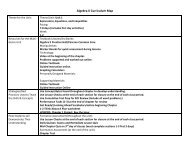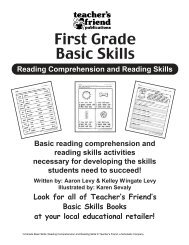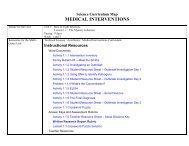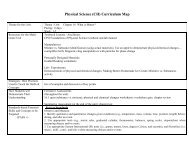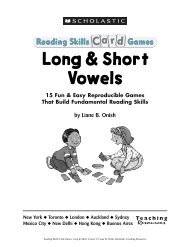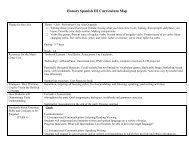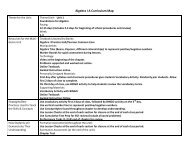Quick-and-Easy Learning Games - Claremore Public Schools
Quick-and-Easy Learning Games - Claremore Public Schools
Quick-and-Easy Learning Games - Claremore Public Schools
- No tags were found...
You also want an ePaper? Increase the reach of your titles
YUMPU automatically turns print PDFs into web optimized ePapers that Google loves.
<strong>Quick</strong>-<strong>and</strong>-<strong>Easy</strong> <strong>Learning</strong> <strong>Games</strong>Phonicsby Wiley BlevinsS C H O L A S T I CP ROFESSIONAL B OOKSNew York • Toronto • London • Auckl<strong>and</strong> • Sydney<strong>Quick</strong>-<strong>and</strong>-<strong>Easy</strong> <strong>Learning</strong> <strong>Games</strong>: Phonics © Scholastic Teaching Resources
DedicationI would like to dedicate this book to my former students, whose zest for learning,innocence, <strong>and</strong> endless laughter have given me so much personal <strong>and</strong> professionalsatisfaction. I would also like to dedicate this book to my gr<strong>and</strong>mother, who neverhad the opportunity to learn to read. It is because of her that I became a teacher.AcknowledgmentsI would like to thank Jeanne Chall, Marilyn Jager Adams, M.E. Curtis, <strong>and</strong> the many other professors,colleagues, <strong>and</strong> classroom teachers who have taught me so much about how children learn to read.Scholastic grants teachers permission to photocopy the games for classroom use. No other part of this publication maybe reproduced in whole or in part, or stored in a retrieval system, or transmitted in any form or by any means, electronic,mechanical, photocopying, recording, or otherwise, without permission of the publisher. For informationregarding permission, write to Scholastic Professional Books, 555 Broadway, New York, NY 10012-3999.Editor: Joan NovelliCover design by Jaime Lucero <strong>and</strong> Vincent CeciCover <strong>and</strong> interior illustration by Paige Billin-FryeInterior design by Sydney WrightISBN 0-590-96380-5Copyright © 1996 by Scholastic Inc. All rights reserved. Printed in the U.S.A.12 11 10 9 8 7 6 5 4 3 2 1 6 7 8 9/9/01/0<strong>Quick</strong>-<strong>and</strong>-<strong>Easy</strong> <strong>Learning</strong> <strong>Games</strong>: Phonics © Scholastic Teaching Resources
ContentsThe Role of Phonics in a Balanced Reading Program . . . . . . . . . . . . . . . . . . . . . . . . .4About this Book . . . . . . . . . . . . . . . . . . . . . . . . . . . . . . . . . . . . . . . . . . . . . . . . . . . . . . .6Go to School . . . . . . . . . . . . . . . . . . . . . . . . . . . . . . . . . . . . . . . . . . . . . . . . . . . . . . . . . .9Children race to school in this consonants game.Spin It! . . . . . . . . . . . . . . . . . . . . . . . . . . . . . . . . . . . . . . . . . . . . . . . . . . . . . . . . . . . . . .13Letters replace numbers in this spinner game that reinforces short vowels <strong>and</strong>word building.Frog Hop . . . . . . . . . . . . . . . . . . . . . . . . . . . . . . . . . . . . . . . . . . . . . . . . . . . . . . . . . . . .16Players hop around the board, using picture clues to guess which short vowels they needto complete words.Build a House . . . . . . . . . . . . . . . . . . . . . . . . . . . . . . . . . . . . . . . . . . . . . . . . . . . . . . . .21Players construct houses, word by word, by combining phonograms with consonants<strong>and</strong> blends.Vowel Checkers . . . . . . . . . . . . . . . . . . . . . . . . . . . . . . . . . . . . . . . . . . . . . . . . . . . . . .26Jumping from one square to another, players read long vowel words to captureopponents’ pieces <strong>and</strong> get to the other side.Sound Bingo . . . . . . . . . . . . . . . . . . . . . . . . . . . . . . . . . . . . . . . . . . . . . . . . . . . . . . . . .28Rain, chain, train . . . this game of bingo helps children build long vowel skills.Raceway . . . . . . . . . . . . . . . . . . . . . . . . . . . . . . . . . . . . . . . . . . . . . . . . . . . . . . . . . . . .30Players pick up vowel spellings from flags along a racetrack to build new words;familiar Shoots <strong>and</strong> Ladders–like shortcuts add to the fun.Build-a-Word . . . . . . . . . . . . . . . . . . . . . . . . . . . . . . . . . . . . . . . . . . . . . . . . . . . . . . . . .33Using letters <strong>and</strong> word parts on cards, players try to form as many words from theparts as they can before they run out of time.Blend TIC-TAC-TOE . . . . . . . . . . . . . . . . . . . . . . . . . . . . . . . . . . . . . . . . . . . . . . . . . . . .36Children put blends <strong>and</strong> word endings together to turn a deck of cards into words.Match It! . . . . . . . . . . . . . . . . . . . . . . . . . . . . . . . . . . . . . . . . . . . . . . . . . . . . . . . . . . . .40Players put beginnings <strong>and</strong> endings together to make words.Roll, Pick, <strong>and</strong> Read . . . . . . . . . . . . . . . . . . . . . . . . . . . . . . . . . . . . . . . . . . . . . . . . . . .42Players roll a die, take the number of cards indicated, then try to make as many wordsfrom the parts as they can.Vowel Concentration . . . . . . . . . . . . . . . . . . . . . . . . . . . . . . . . . . . . . . . . . . . . . . . . . .44Book, look . . . rhyming words make matches in this familiar game.Back to the Barn . . . . . . . . . . . . . . . . . . . . . . . . . . . . . . . . . . . . . . . . . . . . . . . . . . . . . .46R-controlled vowels like bird <strong>and</strong> burn lead the way to the barn in this board game.3<strong>Quick</strong>-<strong>and</strong>-<strong>Easy</strong> <strong>Learning</strong> <strong>Games</strong>: Phonics © Scholastic Teaching Resources
The Role of Phonics ina Balanced Reading ProgramRecently, because of declines in reading test scores <strong>and</strong> concerns aboutthe lack of skills instruction in schools, there has been a renewed interest inphonics instruction. I believe that the teaching of phonics in a meaningfulcontext is an important element in a balanced reading program—one thataddresses the developmental needs of children based on the stage of readingthey are at.To underst<strong>and</strong> how best to meet the needs of beginning readers, here is anoverview of the early stages of reading development. During these stages,children learn sound/spelling correspondences <strong>and</strong> the principles of blending.According to Juel (1991), these stages include:1. Selective-cue stage: During this stage, readers pay more attention to contextualcues, such as context <strong>and</strong> picture clues. Stories that contain repetitivetext structures or rhyming patterns are common reading during this stage <strong>and</strong>help children to predict words while reading.2. Spelling-sound stage: During this stage, readers focus on graphophoniccues. It is during this stage that phonics instruction plays a crucial role as childrenare attending to each letter in words.3. Automatic stage: During this stage, readers utilize both contextual (meaning)<strong>and</strong> graphophonic (phonics) cues. It is during this stage that readersdevelop fluency.4<strong>Quick</strong>-<strong>and</strong>-<strong>Easy</strong> <strong>Learning</strong> <strong>Games</strong>: Phonics © Scholastic Teaching Resources
About this BookThe best way for children to apply their phonics skills is through reading simple, engagingstories that contain a large portion of words that can be blended based on the soundslearned. In addition to the reading of easy text, learning games are an enjoyable way forchildren to practice <strong>and</strong> reinforce their phonics skills. <strong>Games</strong> are especially useful aslearning tools for children who have had difficulty with more traditional learningapproaches.<strong>Quick</strong>-<strong>and</strong>-<strong>Easy</strong> <strong>Learning</strong> <strong>Games</strong>: Phonics focuses on children’s knowledge ofsound/spelling correspondences <strong>and</strong> their ability to blend words. Some of the benefits ofintegrating these games into your reading program follow.• Phonics games provide children with a way to assess their own phonics abilitiesthrough the immediate feedback they receive while playing.• Watching children play phonics games serves as a valuable assessment tool for you,letting you pick up on strengths <strong>and</strong> areas of need as children interact in a relaxedatmosphere.• On a social level, game playing can help children learn to work cooperatively, give<strong>and</strong> take praise <strong>and</strong> criticism, teach others, <strong>and</strong> accept successes <strong>and</strong> failures.The games in <strong>Quick</strong>-<strong>and</strong>-<strong>Easy</strong> <strong>Learning</strong> <strong>Games</strong>: Phonics have been sequenced, using ascope <strong>and</strong> sequence followed by many early reading programs. However, most of thegames can be adapted to review phonics skills other than those designated.Preparing to PlayEach of the 13 games includes the game boards <strong>and</strong> cards your students need to play, plusspinners <strong>and</strong> dice as necessary. To support your instructional goals, each game also comeswith a page of teaching materials that includes:• Players: the recommended number of players in each game group• Skill: the phonics focus in the particular game• To Play: step-by-step directions to share with students• Variations: suggestions for making the game easier, more challenging, <strong>and</strong> so on6<strong>Quick</strong>-<strong>and</strong>-<strong>Easy</strong> <strong>Learning</strong> <strong>Games</strong>: Phonics © Scholastic Teaching Resources
Most of the games in the book can be put together in well under an hour; in fact, some canbe duplicated <strong>and</strong> made ready for play in minutes. The following suggestions will helpyou adapt the games for your class:1. Enlarge game boards, game cards, <strong>and</strong> other game pieces on a photocopier, if desired.2. Paste game boards onto larger pieces of colored construction paper before decorating<strong>and</strong> laminating. (When game boards are on two pages, tape the halves together.)3. Transfer word <strong>and</strong> word building cards onto index cards, then laminate.4. Paste picture cards onto index cards <strong>and</strong> laminate.5. Place the games in an accessible area of your classroom <strong>and</strong> encourage children toplay during free time.One of the best ways to teach children how to play the games—<strong>and</strong> maximize theirgains—is to model as you plan to use them. This can be achieved by playing for bothplayers, playing against children while assisting them, or teaching one group of childrenhow to play the game <strong>and</strong> then having them demonstrate it for their classmates.Getting Families InvolvedYou might find it helpful to make extragames so that children can take them hometo play with family members. Gettingfamilies involved in their children’sgrowing literacy development will havetremendous payoffs.Professional ResourcesAdams, Marilyn Jager. (1990) Beginning to Read: Thinking <strong>and</strong> <strong>Learning</strong> About Print.Cambridge: Massachusetts Institute of Technology.Anderson, R.C., Hiebert, E.H., Scott, J.A., <strong>and</strong> Wilkinson, I.A.G. (1985) Becoming aNation of Readers: The Report of the Commission on Reading. Champaign, IL: Centerfor the Study of Reading.7<strong>Quick</strong>-<strong>and</strong>-<strong>Easy</strong> <strong>Learning</strong> <strong>Games</strong>: Phonics © Scholastic Teaching Resources
Baltis, Joyce, Schafer, Susan. (1996) School Guide to Balanced Reading K–2. New York:Scholastic Professional Books.Chall, Jeanne. (1983) Stages of Reading Development. New York: McGraw-Hill.Honig, Bill. (1995) How Should We Teach Our Children to Read? Center for SystemicSchool Reform. San Francisco State University.Juel, Connie. (1991) “Beginning Reading.” In R. Barr, M. Kamil, P. Mosenthal, <strong>and</strong> P.D.Pearson, eds. H<strong>and</strong>book of Reading Research, Volume II (pp. 759-788). New York:Longman.Wagstaff, Janiel. (1994) Phonics that Work: New Strategies for the Reading/WritingClassroom. New York: Scholastic Professional Books.8<strong>Quick</strong>-<strong>and</strong>-<strong>Easy</strong> <strong>Learning</strong> <strong>Games</strong>: Phonics © Scholastic Teaching Resources
Players: 2 to 4Go to SchoolSkill: consonantsMATERIALSgame board (see pages 10–11)place marker for each playerdie (see page 12)SETUP▲ Make a copy of the game board <strong>and</strong> die.Construct the die by folding along the dottedlines <strong>and</strong> using tape to attach the die tabs to thedie squares.1234TOPL AYEach player chooses a place marker <strong>and</strong> puts it on START (the school bus).The first player throws the die <strong>and</strong> moves his or her marker along the game board path the numberof spaces on the die. (The object of the game is to drive the school bus to the school.)The player then states the name of the consonant on the game board space <strong>and</strong> says a word thatbegins with the sound the consonant st<strong>and</strong>s for. For example, if the player l<strong>and</strong>s on a space withthe consonant t, he or she might say “t . . . table.” If the player is unable to state the consonant’sname or a word that begins with that consonant sound, he or she skips a turn.Each player continues in turn. The first player to reach FINISH (the school) wins.Variations• Make It More Challenging: Have moreskilled players write the words they state on asheet of paper.• Final Consonant Sounds: In this game, eachplayer states a word that ends with the soundthe consonant st<strong>and</strong>s for. Prepare the gameboard by replacing the letters h <strong>and</strong> qu with x.Write the new letters on self-stick tags orsmall pieces of white tape.• Digraphs <strong>and</strong> Blends: Replace consonantson the game board with digraphs (ch, th, sh,wh, ph) <strong>and</strong> blends (bl, br, cl, cr, dr, fl, fr, gl,gr, pl, pr, sc, sk, sl, sm, sn, sp, st, sw, tr, tw).• Vowels: Replace consonants on the gameboard with short vowels (a, e, i, o, u), longvowel spellings (ai, ay, ea, ee, ie, y, igh, oa,ow), diphthongs <strong>and</strong> variant vowels (oi, oy,au, aw, ou, ow, oo), or r-controlled vowels(ar, er, ir, or, ur).9<strong>Quick</strong>-<strong>and</strong>-<strong>Easy</strong> <strong>Learning</strong> <strong>Games</strong>: Phonics © Scholastic Teaching Resources
Go to SchoolGame Board10<strong>Quick</strong>-<strong>and</strong>-<strong>Easy</strong> <strong>Learning</strong> <strong>Games</strong>: Phonics © Scholastic Teaching Resources
Go to SchoolGame Board11<strong>Quick</strong>-<strong>and</strong>-<strong>Easy</strong> <strong>Learning</strong> <strong>Games</strong>: Phonics © Scholastic Teaching Resources
Players: 2 to 5Spin It!Skill: short vowelsMATERIALS3 spinners (see pages 14–15)paper <strong>and</strong> pencilsSETUP▲ Copy <strong>and</strong> cut out the three spinners <strong>and</strong>dials. Paste them in sequence on a piece of tagboard or the inside of a folder.▲ Using a brass fastener, attach the dials to thespinners. (You might also want to make thesefrom tag board.)123Each player in turn spins all threespinners. The player writes the lettersselected by the spinner dials inorder—Spinner 1, first; Spinner 2,second; Spinner 3, third.If a word can be formed from theseletters, the player states the wordaloud <strong>and</strong> writes it on his or herpaper. Each word earns one point.Proper names, such as Sam or Pat,are allowed.The first player to get 10 points wins.TOPL AYVariations• Change the Rules: Let children place theirletters in any order to form words.• Make New Spinners: Occasionally replacethe spinners to update the game. (Use theblank spinner.) Suggestions follow:Spinner 1: Replace the consonants withdigraphs <strong>and</strong> blends.Spinner 2: Replace the short vowels with longvowel digraphs (ai, ay, ea, ee, ie, igh, y, oa,ow).Spinner 3: Replace some of the ending consonantswith ck, ff, ll, ss, ch, sh, <strong>and</strong> th.13<strong>Quick</strong>-<strong>and</strong>-<strong>Easy</strong> <strong>Learning</strong> <strong>Games</strong>: Phonics © Scholastic Teaching Resources
Spin It!Spinners14<strong>Quick</strong>-<strong>and</strong>-<strong>Easy</strong> <strong>Learning</strong> <strong>Games</strong>: Phonics © Scholastic Teaching Resources
Spin It!Spinners15<strong>Quick</strong>-<strong>and</strong>-<strong>Easy</strong> <strong>Learning</strong> <strong>Games</strong>: Phonics © Scholastic Teaching Resources
Players: 2 or 4Frog HopSkill: short vowelsMATERIALSgame board (see pages 17–18)game cards (see pages 19–20)place marker for each playerSETUP▲ Make a copy of the game board <strong>and</strong> gamecards. On the back of each game card, write theanswer or completed word.▲ Shuffle the cards <strong>and</strong> place them faceup onthe game board.123TOPL AYEach player chooses a place marker <strong>and</strong> puts it onSTART.The first player picks a card <strong>and</strong> moves his or hermarker along the game board path to the nextspace with the short vowel that completes theword on the card. For example, if the playerpicks a card with p__g, he or she must moveto the next i space. (Decide together what happensif a child chooses an incorrect shortvowel.) Players can use the picture on eachcard as a clue.Each player continues in turn. The first play-Variations• Long Vowels: Make picture cards of objectsthat contain multiple spellings of the longvowels (ai, ay, ea, ee, ie, igh, y, oa, ow). Thepictures might show train, rain, mail, nail,hay, play, crayon, bean, leaf, peach, peanut,sea, deer, sleep, street, feet, wheel, teeth,fifteen, bee, knee, three, pie, tie, fly, sky, cry,boat, coat, soap, road, toast, goat, loaf, toad,snow, bowl, arrow, window. Using small,self-stick tags, replace the short vowels on thegame board with the long vowel spellings.Play the game as before.16<strong>Quick</strong>-<strong>and</strong>-<strong>Easy</strong> <strong>Learning</strong> <strong>Games</strong>: Phonics © Scholastic Teaching Resources
Frog HopGame Board17<strong>Quick</strong>-<strong>and</strong>-<strong>Easy</strong> <strong>Learning</strong> <strong>Games</strong>: Phonics © Scholastic Teaching Resources
Frog HopGame Board18<strong>Quick</strong>-<strong>and</strong>-<strong>Easy</strong> <strong>Learning</strong> <strong>Games</strong>: Phonics © Scholastic Teaching Resources
Frog HopGame Cardsc t b ghtfnhndvntnhnjtwbnstdskpghll19<strong>Quick</strong>-<strong>and</strong>-<strong>Easy</strong> <strong>Learning</strong> <strong>Games</strong>: Phonics © Scholastic Teaching Resources
Frog HopGame Cardsl ps g ftkcksxfrgsckmpbxdgrgbgntsncp20<strong>Quick</strong>-<strong>and</strong>-<strong>Easy</strong> <strong>Learning</strong> <strong>Games</strong>: Phonics © Scholastic Teaching Resources
Players: 2Build a HouseSkill: phonogramsMATERIALSgame boards (see pages 22–23)game cards (see pages 24-25)space markers/tokensSETUP▲ Make a copy of the game boards <strong>and</strong> gamecards. Game cards are provided for two to fourgames.▲ Place the game cards facedown on the gameboard.123TOPL AYEach player or team chooses a house to build,then draws a card from the card pile.If a word can be formed by combining the consonantor blend on the card <strong>and</strong> one of the phonogramson the house, the player covers that squareon the house with a marker. The player thenreturns the card to the bottom of the pile. If aword cannot be formed, the player just returns thecard to the bottom of the pile <strong>and</strong> waits until thenext turn.Each player or team continues in turn. The firstplayer to build a house (fill all the spaces in his orher house) wins.Variations• To Vary the Difficulty: Mix <strong>and</strong> match thegame boards <strong>and</strong> game pieces to the level ofdifficulty desired. For example, to simplifythe game, use only three phonograms. Writeeach phonogram three times on the house inr<strong>and</strong>om order. This allows players to focus onword families. (Players may not form thesame word twice.)• Make New <strong>Games</strong>: Using other phonograms,make new houses. You might chooseto use phonograms from your weeklyspelling list.21<strong>Quick</strong>-<strong>and</strong>-<strong>Easy</strong> <strong>Learning</strong> <strong>Games</strong>: Phonics © Scholastic Teaching Resources
Build a HouseGame Boardankilluckapinockallanugackunkellestopatickipumpcards22<strong>Quick</strong>-<strong>and</strong>-<strong>Easy</strong> <strong>Learning</strong> <strong>Games</strong>: Phonics © Scholastic Teaching Resources
Build a HouseGame Boardashineakeiceoreateinkameighteatideokeainingaleawayorcards23<strong>Quick</strong>-<strong>and</strong>-<strong>Easy</strong> <strong>Learning</strong> <strong>Games</strong>: Phonics © Scholastic Teaching Resources
Build a HouseGame Cardsb c d fghjklmnprstvwyzfree spacebrlose aturn24<strong>Quick</strong>-<strong>and</strong>-<strong>Easy</strong> <strong>Learning</strong> <strong>Games</strong>: Phonics © Scholastic Teaching Resources
Build a HouseGame Cardsbl br cl crdrflfrgrgltrsmspslswchshfree spacethwhlose aturn25<strong>Quick</strong>-<strong>and</strong>-<strong>Easy</strong> <strong>Learning</strong> <strong>Games</strong>: Phonics © Scholastic Teaching Resources
Players: 2Vowel CheckersSkill: final eMATERIALSgame board (see page 27)24 checkers or markers (12 of one color,12 of another color)SETUP▲ Make a copy of the game board. Set up thegame as you would a regular checkers game.You can also use a ready-made checkerboard<strong>and</strong> checkers. If so, use self-stick tags <strong>and</strong> writethe words provided on page 27 on the checkerboard.1TOPL AYThe game is played just like checkers, except players must read the word on each space he orshe l<strong>and</strong>s on. If a player cannot read the word, he or she returns to the original space.You might wish to review with players the following rules for playing checkers:• Players take turns, moving one checker per turn. The checkers may be moved diagonally forwardone square. For example, the player using the shaded squares can move his or her checkerson shaded squares only.• A player can capture an opponent’s checker byjumping over it. The square behind the checkerbeing jumped must be empty. The player thentakes the jumped checker <strong>and</strong> places it to the sideof the game board. Players must jump othercheckers when they can. A player can jumpmore than one checker at a time, provided themoves are forward.Variations• Short Vowels: Replace the words on thecheckerboard with short vowel words.• Multiple Spellings of Long Vowels: Replacethe words on the checkerboard with wordscontaining the multiple spellings of each longvowel (a_e, ai, ay, e_e, e, ea, ee, i_e, ie, igh,y, o_e, oa, ow, u_e).26<strong>Quick</strong>-<strong>and</strong>-<strong>Easy</strong> <strong>Learning</strong> <strong>Games</strong>: Phonics © Scholastic Teaching Resources
Vowel CheckersGame BoardgrademadepetPetepinpinerodrodeSamsameatategradgradepastpasteripripecubcubematmatecancaneplanplanebitbitehughugenotnotefatfatehidhidekitkiteJanJaneususehathateridridequitquiteglobglobehophopecapcapeTimtimefinfinerobrobemanmanetaptape27<strong>Quick</strong>-<strong>and</strong>-<strong>Easy</strong> <strong>Learning</strong> <strong>Games</strong>: Phonics © Scholastic Teaching Resources
Players: any #Sound BingoSkill: long vowelsMATERIALSgame board (see page 29)space markersSETUP▲ Make copies of the game board. Use thewords here to fill in the cards. Put the words in adifferent order for each card. Also, write eachword on a small slip of paper <strong>and</strong> place in a bag.Game 1 (Long A <strong>and</strong> Long E): make, bake,pail, snail, rain, chain, train, wait, day, say,play, stay, bee, tree, seed, speed, week, queen,keep, sheep, street, leaf, bean, teamGame 2 (Long I, Long O, <strong>and</strong> Long U): pie,tie, fly, cry, spy, sigh, high, bike, lime, kite,boat, load, soap, coach, snow, grow, flow, toe,goes, bone, hope, home, cute, huge1234TOPL AYSound Bingo is played just like regular bingo. Before the game begins, give each player a gameboard <strong>and</strong> ample space markers. The caller draws one slip of paper from the bag <strong>and</strong> reads theword aloud.If a player’s game board contains that word, he or she places a marker over the space.The first player to get five markers in a row either vertically, horizontally, or diagonally, yells“Sound Bingo.” The player then reads the words aloud in the row as the caller checks themagainst the slips of paper drawn from the bag. If these match, the player wins.Players then clear their boards, the slips of paper go back in the bag, <strong>and</strong> a new game begins.Variations• More Long Vowels: Use other words withlong vowel spellings.• Blends: Use your own word lists or thefollowing list for making game boardscontaining blends: black, brown, clean, crop,drop, flat, free, glow, green, plan, present,stamp, small, snake, speak, tree, sleep, scare,swing, twin, splash, spring, square, string.28<strong>Quick</strong>-<strong>and</strong>-<strong>Easy</strong> <strong>Learning</strong> <strong>Games</strong>: Phonics © Scholastic Teaching Resources
Sound BingoGame BoardSOUND BINGOFREE29<strong>Quick</strong>-<strong>and</strong>-<strong>Easy</strong> <strong>Learning</strong> <strong>Games</strong>: Phonics © Scholastic Teaching Resources
Players: 2 to 4RacewaySkill: long vowelsMATERIALSgame board (see pages 31–32)die (see page 12)place marker for each playerSETUP▲ Make a copy of the game board <strong>and</strong> die.Construct the die by folding along the dottedlines <strong>and</strong> using tape to attach the die tabs to thedie squares.▲ Make an answer key card for players to checkif they are challenged during the game. Includethe following words: rain, plea, play, bean,keep, snow, seep, soap, mean, moan, toast,reed, read, road, raid, monkey, tea, tow, toe,tie, fleas, flies, flows, train, honey, eat, oat,deep, fleet, float, seal, sail, key, goes, sea, see,say, sow, grow, gray, beat, beet, boat, bait, pea,pay, pie, tree, tray, beach, clean, wait, leaf.1234TOPL AYEach player chooses a place marker <strong>and</strong> puts it on START (the beginning of the race).The first player throws the die <strong>and</strong> moves his or her marker along the game board path the numberof spaces on the die.The player then uses one of the vowel spellings in the flags alongside the game board to completethe word. The player states the word formed <strong>and</strong> spells it. If other players want to challengethe spelling, they can check the key card.Each player continues in turn. The first player to reach FINISH (the checkered flag) wins.Variations• Short Vowels: Using self-stick tags, replacethe incomplete words on the game board withincomplete words containing short vowels.Replace the flags with short vowel spellings(a, e, i, o, u, ea as in bread).30<strong>Quick</strong>-<strong>and</strong>-<strong>Easy</strong> <strong>Learning</strong> <strong>Games</strong>: Phonics © Scholastic Teaching Resources
RacewayGame Board31<strong>Quick</strong>-<strong>and</strong>-<strong>Easy</strong> <strong>Learning</strong> <strong>Games</strong>: Phonics © Scholastic Teaching Resources
RacewayGame Board32<strong>Quick</strong>-<strong>and</strong>-<strong>Easy</strong> <strong>Learning</strong> <strong>Games</strong>: Phonics © Scholastic Teaching Resources
Players: 2Build-a-WordSkill: consonant digraphsMATERIALSresponse sheet (see page 34)game cards (see page 35)pencilstimerSETUP▲ Distribute one game card <strong>and</strong> response sheetto each player or team.123TOUsing the letters <strong>and</strong> word parts on theword-building card, each player or teamforms as many words as possible, recordingwords in the appropriate column on theresponse sheet. Each player or team hasfive minutes to form words. (Or whatevertime you decide.) Use a timer or appoint amonitor to time the game.After the allotted time, players or teamsthen switch game cards <strong>and</strong> the gameresumes.Players or teams receive one point for eachword formed. The player or team with themost points at the end of the game wins.PL AYVariations• Make It More Challenging: Adjust the playingtime. For example, limit playing time tothree minutes.• Make New Game Cards: Use different wordparts or combinations of digraphs to makenew game cards. Add the digraph ph to someof the cards.• Play Cooperatively: Have students worktogether to form as many words as they can infive minutes.33<strong>Quick</strong>-<strong>and</strong>-<strong>Easy</strong> <strong>Learning</strong> <strong>Games</strong>: Phonics © Scholastic Teaching Resources
Build-a-WordResponse SheetName:chshthwh34<strong>Quick</strong>-<strong>and</strong>-<strong>Easy</strong> <strong>Learning</strong> <strong>Games</strong>: Phonics © Scholastic Teaching Resources
Build-a-WordWord-Building Cardschshlunipriillpinopbenbruthwhapeineeninkfitraickcloileatingizbamaichale35<strong>Quick</strong>-<strong>and</strong>-<strong>Easy</strong> <strong>Learning</strong> <strong>Games</strong>: Phonics © Scholastic Teaching Resources
Players: 2Blend TIC-TAC-TOESkill: consonant blendsMATERIALSgame boards (see pages 37–39)pencilsSETUP▲ Make copies of the game boards.▲ Place the game boards in a folder. Have playersselect the game board they want. (Youmight want to laminate a set <strong>and</strong> have childrenuse markers that wipe off. This way, playerscan reuse the games.)123TOPL AYThe game is similar to a st<strong>and</strong>ard game of tic-tac-toe.Each player must first choose to be either X’s or O’s.In turn, each player then marks an X or an O on onesquare of the TIC-TAC-TOE grid. In order for aplayer to mark an X or an O on a square, he or shemust first add one of the blends listed above theTIC-TAC-TOE grid to the word ending on thesquare to form a word. The player reads aloud theword. If both players agree that the word is correct,the player can mark that square.The player who gets three X’s or three O’s in a rowVariations• Add New Blends: Using the same gameboards, replace the blends with digraphs <strong>and</strong>other 2- <strong>and</strong> 3-letter blends such as ch, sh, th,wh, ph, gl, pr, sc, sl, sw, tw, spl, scr, spr, squ,str, <strong>and</strong> shr.• Add Endings: Reverse the game. Using ablank game board, write only the beginningblend or digraph. Students make words byadding ending phonograms.36<strong>Quick</strong>-<strong>and</strong>-<strong>Easy</strong> <strong>Learning</strong> <strong>Games</strong>: Phonics © Scholastic Teaching Resources
Blend TIC-TAC-TOEGame Boardblbrclcrpl______ ack______ own______ ue______ ank______ ot______ ow______ ock______ ick______ ash37<strong>Quick</strong>-<strong>and</strong>-<strong>Easy</strong> <strong>Learning</strong> <strong>Games</strong>: Phonics © Scholastic Teaching Resources
Blend TIC-TAC-TOEGame Boardflfrdrgrtr______ y______ ill______ op______ ew______ ain______ ip______ ap______ ash______ ight38<strong>Quick</strong>-<strong>and</strong>-<strong>Easy</strong> <strong>Learning</strong> <strong>Games</strong>: Phonics © Scholastic Teaching Resources
Blend TIC-TAC-TOEGame Boardsksmsnspst______ oke______ ell______ all______ ack______ are______ eak______ iff______ unk______ ill39<strong>Quick</strong>-<strong>and</strong>-<strong>Easy</strong> <strong>Learning</strong> <strong>Games</strong>: Phonics © Scholastic Teaching Resources
Players: 2Match It!Skill: consonant blends <strong>and</strong> digraphsMATERIALSgame cards (see page 41)blackSETUP▲ Make multiple copies of the game cards.▲ On each card write the word parts. For theword black, for example, write the letters bl tothe far right of the game card <strong>and</strong> the letters ackto the far left of the card (see sample, left). Inthis way, students can read the words withgreater ease as they form them. Use the followingword list to begin: bl/ack, tr/ee, ch/air,sh/op, st/amp, fl/at, sm/all, pl/ace, dr/aw.123TOPL AYShuffle the cards <strong>and</strong> place the stack facedown. Give two cards to each player.The first player draws a card from the stack. If the player can use the card to form a word withone other card in his or her h<strong>and</strong>, the player reads aloud the word <strong>and</strong> places the two cardsdown. If the player can’t form a word, he or she keeps the cards. The next player takes a turn,proceeding in the same way.When all the cards are gone from the stack, players draw cards from each other until all possiblewords can be formed. The player with the most cards at the end of the game wins.Variations• Make More Cards: Increase the card deck to36 cards using the following words: wh/ite,th/in, br/own, cl/ean, gr/een, sp/eak, spl/ash,pr/ice, gl/ow. Make additional game cardsusing words that begin with other digraphs orblends. Divide the words between the blendor digraph <strong>and</strong> the phonogram.• Spell It: Make game cards using your weeklyspelling words.40<strong>Quick</strong>-<strong>and</strong>-<strong>Easy</strong> <strong>Learning</strong> <strong>Games</strong>: Phonics © Scholastic Teaching Resources
Match it!Game Cards41<strong>Quick</strong>-<strong>and</strong>-<strong>Easy</strong> <strong>Learning</strong> <strong>Games</strong>: Phonics © Scholastic Teaching Resources
Players: 2 to 4Roll, Pick, <strong>and</strong> ReadSkill: diphthongsMATERIALSgame cards (see page 43)die (see page 12)paper <strong>and</strong> pencilsclrawSETUP▲ Make a copy of the game cards <strong>and</strong> the die.Using the die on page 12 as a pattern, make adie with the numbers 2 to 5 <strong>and</strong> the words losea turn.▲ Shuffle the game cards <strong>and</strong> spread them facedownon a table or place them in a bag.loud123TOPL AYThe first player rolls the die <strong>and</strong> selects the number of cards marked on the die. For example, ifa player rolls a 5, he or she picks 5 cards from the bag or picks up 5 cards off the table.Using the cards selected, the player tries to form as many words as possible, recording them onpaper. Each word earns one point.Each player continues in turn. The first player to earn 10 points wins.Variations• Vary the letters <strong>and</strong> word parts on the gamecards by adding new sounds to the card deck.Most vowel patterns can be used.• Silent Letters: Make new game cards withthe words lamb, comb, wrong, right, know,knee, climb, wrap, gnat. Students pick thenumber of cards on the die, read the words,<strong>and</strong> identify the silent letters.42<strong>Quick</strong>-<strong>and</strong>-<strong>Easy</strong> <strong>Learning</strong> <strong>Games</strong>: Phonics © Scholastic Teaching Resources
Roll, Pick, <strong>and</strong> ReadGame Cardsoud ound oil oyaulauseawoinspmawnouthhcplclsrfbtjdr43<strong>Quick</strong>-<strong>and</strong>-<strong>Easy</strong> <strong>Learning</strong> <strong>Games</strong>: Phonics © Scholastic Teaching Resources
Players: 2Vowel ConcentrationSkill: vowel digraph ooMATERIALSgame cards (see page 45)SETUP▲ Make a copy of the game cards.▲ Spread out the cards facedown on a table.12TOPL AYIn turn, each player turns over two cards <strong>and</strong> reads aloud the word on each card. If the twoselected cards contain a rhyming pair, such as book <strong>and</strong> look, the player gets to keep the cards.If the cards do not rhyme, the player turns the cards over in their original position. The objectof the game is to remember where words are located so that pairs can be formed in future turns.Each player continues in turn until all the pairs have been found. The player with the mostcards at the end of the game wins.Variations• Building Sentences: Players must use bothrhyming words in sentences in order to earnthe set.• Add New Cards: Add new cards containingthe following words: shook, brook, wood,hood, bloom, broom, cool, pool, droop, hoop,goose, moose, pool, tool, stoop, scoop.• Diphthongs <strong>and</strong> Variant Vowels: Make cardsusing the following sets of words: cow/now;flower/shower; mouth/south; cloud/loud;coin/join; soil/spoil; toy/boy; brown/clown;down/town; frown/gown; cause/pause;saw/claw; straw/draw; sound/round;mouse/house.44<strong>Quick</strong>-<strong>and</strong>-<strong>Easy</strong> <strong>Learning</strong> <strong>Games</strong>: Phonics © Scholastic Teaching Resources
Vowel ConcentrationGame Cardsbookcooktooklookgoodstoodmoonsoonspoonnoonroomzoomshootboot45<strong>Quick</strong>-<strong>and</strong>-<strong>Easy</strong> <strong>Learning</strong> <strong>Games</strong>: Phonics © Scholastic Teaching Resources
Players: 2 to 4Back to the BarnSkill: r-controlled vowelsMATERIALSgame board (see pages 47–48)die (see page 12)place marker for each playerSETUP▲ Make a copy of the game board <strong>and</strong> die.Construct the die by folding along the dottedlines <strong>and</strong> using tape to attach the die tabs to thedie squares.1234TOPL AYEach player chooses a place marker <strong>and</strong> puts it on START (the pasture gate).The first player throws the die <strong>and</strong> moves his or her marker along the game board path the numberof spaces on the die.The player then reads the word on the game board space. If the player is unable to read theword, he or she loses a turn.Each player continues in turn. The first player to reach FINISH (the barn) wins.Variations• Building Sentences: Players read the wordsthey l<strong>and</strong> on <strong>and</strong> use them in sentences.• Vary the Game Board: Replace the wordswith other r-controlled words.• Diphthongs <strong>and</strong> Variant Vowels: Using selfsticktabs, replace the r-controlled vowelwords with words containing diphthongs <strong>and</strong>variant vowel spellings. You might wish touse the following word list: boy, joy, toy, soil,coin, spoil, join, point, cause, pause, drawn,saw, claw, loud, cloud, round, sound, mouth,book, took, good, moon, room, boot, scoop.46<strong>Quick</strong>-<strong>and</strong>-<strong>Easy</strong> <strong>Learning</strong> <strong>Games</strong>: Phonics © Scholastic Teaching Resources
Back to the BarnGame Board47<strong>Quick</strong>-<strong>and</strong>-<strong>Easy</strong> <strong>Learning</strong> <strong>Games</strong>: Phonics © Scholastic Teaching Resources
Back to the BarnGame Board48<strong>Quick</strong>-<strong>and</strong>-<strong>Easy</strong> <strong>Learning</strong> <strong>Games</strong>: Phonics © Scholastic Teaching Resources





